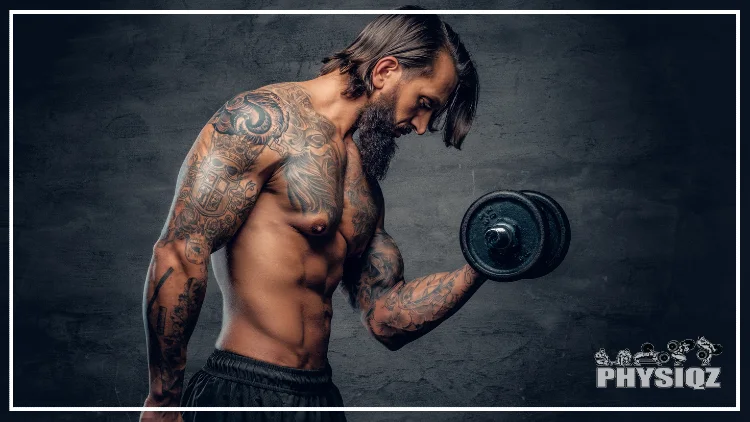
The shoulders and biceps are relatively small muscle groups, but they have a significant impact on the physique and the majority of lifters desire having big guns and boulder-like shoulders; therefore, the key is to implement a shoulder and bicep workout program using dumbbells, kettlebells and/or a barbell in order to effectively grow these muscles.1
For many lifters, the biceps and shoulders prove to be pesky muscles that simply won’t grow for a number of reasons—the proven trick for more mass in these two muscles is ensuring all heads are properly hit while ascertaining that volume landmarks are followed—which many gym bros simply fail to miss.
Dumbbell Shoulder and Bicep Workout Routine (Shoulder and Arm Workout With Dumbbells)
Dumbbells are a versatile training tool to the lifter when compared to the barbell because they offer a number of benefits that their counterparts do not. These include providing the lifter:
- Increased range of motion (ROM) which is the extent to which a muscle or joint can move through a plane as anatomically as is possible. Since they are free weights, they allow for movement in a more natural manner as opposed to the restrictions placed by the use of the barbell.
- They allow for a unilateral exercise since each arm is holding the load which helps prevent muscle imbalances brought on by the stronger hand compensating for the weaker hand.
- Dumbbells are great for challenging stability since the stabilization muscles must work to keep them in a proper ROM and they are ideal for beginners.2
The information below summarizes the workouts a lifter can use for a bicep and shoulder workout using dumbbells, both of which are among the hardest muscle to grow.
This shoulders biceps workout displays loads that are a percentage of their 1RM (one rep max is the maximum weight that a lifter can do in one rep), and their reps in reserve or RIR (the number of reps that are left before a lifter reaches technical failure).
- Arnold Press: 3 sets of 10 reps at 70% of 1RM (1 Rep Max) with a RIR of 1-3
- Seated Dumbbell Shoulder Press: 3 sets of 8 reps at 70% of 1RM (1 Rep Max) with a RIR of 1-3
- Lateral Raises: 3 sets of 8 reps at 60-80% of 1RM (1 Rep Max) with a RIR of 1-3
- Bicep Curls: 3 sets of 8 reps at 70-80% of 1RM (1 Rep Max) with a RIR of 1-3
- Dumbbell Concentration Curl: 3 sets of 8 reps at 75-85% of 1RM (1 Rep Max) with a RIR of 1-3
- Incline Hammer Curls: 3 sets of 9 reps at 60-80% of 1RM (1 Rep Max) with a RIR of 1-3
- Dumbbell Hammer Curl and Press: 4 sets of 10 reps at 75-85% of 1RM (1 Rep Max) with a RIR of 1-3
Lifters aiming for muscle growth find that using 60% to 80% of their one-repetition maximum (1RM) is most effective. This range promotes mass hypertrophy and strength better than just aiming for higher 1RMs, which tends to increase strength without significantly enhancing muscle size.
The proven trick for more mass would be to ensure that all heads of both the shoulders (front, side and delts) and biceps (short and long head) are adequately trained and volume landmarks are adhered to for results.
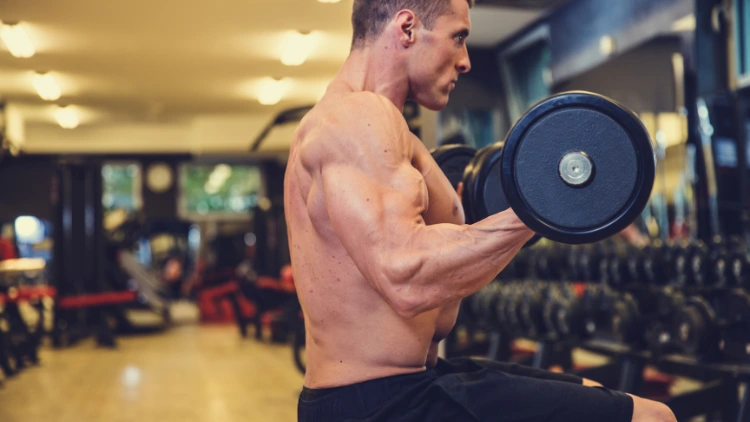
Source: milan2099 via Canva.com3
1. Arnold Press
Created by Arnold Schwarzenegger, the Arnold press is a classic and due to the rotational aspect and it being a multiplanar movement, it works the anterior and lateral delts as well as the rotator cuff. It is also versatile because it can be done while sitting or standing, and even on an incline, but the lifter should make sure that the dumbbells come over the head and not in front of it.
They are great for warming up the shoulders and providing the shoulders with a complete burnout. As they effectively activate all 3 heads of the delts, they are a viable option for lifters who have bad shoulder genetics.
How to perform the Arnold press: Using dumbbells, the lifter should commence by lifting them to shoulder height while ensuring that the arms are bent and palms facing inward towards the torso. Initiate the movement by pressing the dumbbells overhead while rotating dumbbells outwards until the palms are now facing forward at the top of the movement.
Descend the dumbbells by slowly lowering the weight and then reversing the rotation such that the elbows are bent and palms now once again facing the body. The lifter should pay mind not to arch their back as they press up.
- Reps: 10-12
- Sets: 2-3
- % of 1RM: 70
- RIR (Reps in Reserve): As mentioned before, the reps in reserve are the number of reps a lifter has left before reaching technical failure. In this case, a lifter may be able to perform 8-11 reps in total, but they should initially have 1-3 reps in reserve. However, they should push close to reaching a 1 RIR on the third week of the 5 week program. This applies to all the other exercises below as well.
- Rest: 60 seconds
- Superset with: Front raises
2. Seated Dumbbell Shoulder Press
The dumbbell press is one of the compound shoulder exercises that works different multiple muscle groups including the shoulders and triceps. It is a functional exercise that enhances shoulder strength. By using dumbbells, there is a need for stabilization which improves balance.
How to perform the Shoulder press: While sitting on a bench, hold two dumbbells at shoulder height with an overhand grip. Press the dumbbells up above the head until the arms are fully extended. Slowly return to the starting position.
- Reps: 8-10
- Sets: 3
- % of 1RM: 70
- RIR (Reps in Reserve): 1-3
- Rest: 60 seconds
- Superset with: Front plate raises
3. Lateral Raises
Lateral raises are an excellent shoulder exercise that pack on mass, giving the shoulders definition and shape and making them stronger. Their activation of the front delts is second only to the overhead shoulder press and their engagement of the medial (side) delts is markedly higher than both bench press and dumbbell flye.4 Lateral raises are usually completed with a light weight.
How to perform the lateral raises: Hold a pair of dumbbells by the side of the torso with palms facing inwards towards the body. Keep the body sill and core engaged ensuring that there is no swinging and lift the dumbbells out to the side slightly bending at the elbows. The arms should be lifted until they are parallel to the floor and lower slowly back to the starting position.
- Reps: 8-15
- Sets: 3
- % of 1RM: 60-80
- RIR (Reps in Reserve): 1-3
- Rest: 60 seconds
- Superset with: Upright rows
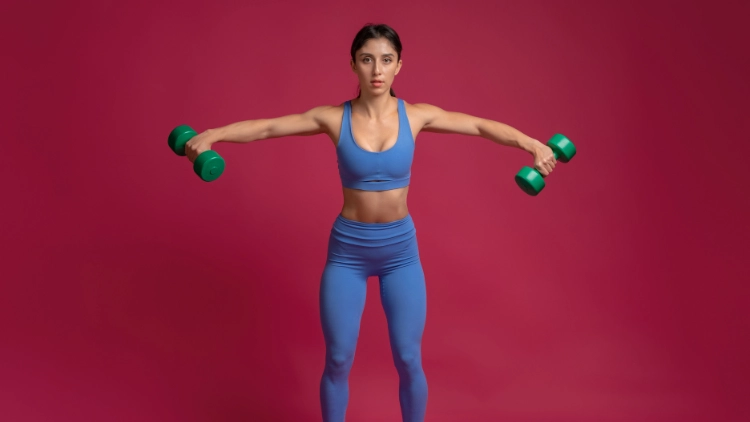
Source: Sergey Nazarov via Canva.com5
4. Bicep Curls
Bicep curls are a viable complement to their barbell counterpart as they help address muscle imbalances and demand stabilization from the lifter. Varying the exercise by rotating the dumbbell will lead to an opening of the bicep at the top of the movement leading to activation of both inner and outer heads of the muscle. Biceps curls are ideal bicep workouts for women looking to tone and sculpt their arms.
How to perform the bicep curl: These can either be done by alternating arms or performing a set on each arm. Maintain a straight back and upright chest, and in a controlled motion, curl the arms up by bending at the elbow. There should be no swinging and / or use of momentum; lower the weight if this is the case because the biceps are not really being engaged and may cause injury.
- Reps: 8-12
- Sets: 3
- % of 1RM: 70-80
- RIR (Reps in Reserve): 1-3
- Rest: 60 seconds
- Superset with: Inverted row
5. Dumbbell Concentration Curls
Dumbbell concentration curls are the most ideal exercises for the biceps because they produce the greatest extent of muscle activation. They do use lighter weight then the other biceps exercises and should be left towards the end of the workout.
How to perform the dumbbell concentration curl: Sitting on an exercise bench and holding a dumbbell in one hand, the lifter should lean forward and place their upper arm on the inside of the thigh and let the dumbbell hang down. While keeping the exercising arm against the thigh, bend the elbow and curl the dumbbell to the shoulder. Slowly lower the arm and repeat.
- Reps: 8-11
- Sets: 3
- % of 1RM: 75-85
- RIR (Reps in Reserve): 1-3
- Rest: 60 seconds
- Superset with: Dumbbell lying triceps extensions
6. Incline Hammer Curls
Incline hammer curls are a movement that primarily target the biceps and forearms but also engage the shoulder muscles as they act as stabilizers and support in the movement. They are typically performed on an incline bench that is set at a 45 degree angle. The angle of incline will also result in an increase in ROM, resulting in greater activation of the biceps.6
This greater focus allows for superior hypertrophy rates making incline hammer curls a serious consideration for individuals with bad bicep genetics.
How to perform the incline hammer curls: Hold a dumbbell in each hand while sitting on an incline bench angled at 45 degrees. While keeping the upper arm still and palms facing inwards, lift the dumbbell to shoulder height and slowly bring down back to side and repeat.
- Reps: 7-11
- Sets: 3
- % of 1RM: 60-80
- RIR (Reps in Reserve): 1-3
- Rest: 60 seconds
- Superset with: Inverted row
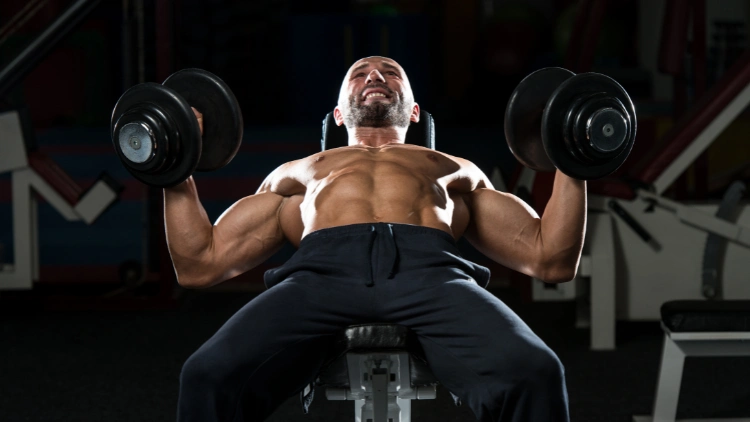
Source: Ibrakovic via Canva.co7
7. Dumbbell Hammer Curl and Press
This should be the final exercise of the routine and it engages both the biceps and shoulders leaving the muscles ‘pumped’ and expended, encouraging growth. Due to the pressing movement, the triceps are activated, making it a complete shoulders biceps triceps workout.
How to perform the dumbbell hammer curl and press: They can be done seated and / or standing; holding a dumbbell by the sides in each hand with palms facing the legs, bend the arms and curl the dumbbells up to the shoulders. The wrists should not be rotated and the final step is to press the dumbbells as in a shoulder press. Lower the dumbbells back to the shoulders, then to the sides. This counts as one rep.
- Reps: 10-12
- Sets: 4
- % of 1RM: 75-85
- RIR (Reps in Reserve): 1-3
- Rest: 60 seconds
- Superset with: Front raises
The Ultimate Barbell Shoulder and Bicep Workout Program
This shoulder and bicep workout program uses the barbell rather than dumbbell to target both the biceps and shoulders. Barbells offer some advantages over dumbbells including:
- They allow the lifter to haul more weight allowing them to progressively overload the weight thus making them among the bicep workouts for mass gains.
- Barbells allow for more compound movements allowing simultaneous activation of several muscle groups.
As with dumbbells, exercises are summarized below and delved deeper in the sections that follow.
- Barbell Overhead Press: 4 sets of 8 reps at 60-80% of 1RM (1 Rep Max) with a RIR of 1-3
- Wide-Grip Barbell Curl: 5 sets of 4 reps at 70% of 1RM (1 Rep Max) with a RIR of 1-3
- Barbell Shrugs: 3 sets of 12 reps at 80% of 1RM (1 Rep Max) with a RIR of 1-3
- Landmine Press: 3 sets of 8 reps at 70% of 1RM (1 Rep Max) with a RIR of 1-3
Barbell Overhead Press
The barbell overhead press is a compound movement that targets all heads of the shoulder muscle (front delts, side and rear delts) allowing for heavier weights. In addition, it engages the triceps, traps, biceps, back and core muscles. They are a functional exercise for everyday activities like lifting a heavier item off an upper shelf and they are great at improving the posture since they also activate the core muscles.8
How to perform the barbell overhead press: Hold a barbell with the starting position at shoulder height and palms facing forward. Feet should be shoulder width apart and the back straight, glutes and abs engaged and shoulders retracted. This provides a stable platform to press the barbell up and prevents using the legs to do so. The barbell should be pressed straight up to an arm’s length and lowered back to the shoulders for the next rep.
- Reps: 6-8
- Sets: 4
- % of 1RM: 60-80
- RIR (Reps in Reserve): 1-3
- Rest: 60 seconds
- Superset with: Lateral raise
Wide-Grip Barbell Curl
The wide grip barbell curl is a variation of the classic barbell curl that targets both the forearms and the biceps. As a result of the width grip that uses the pull force, the inner (short) head of the bicep is more of the focus of the exercise and is actively engaged. A superset with the barbell overhead press here will make for an efficient bicep superset workout.
How to perform wide-grip barbell curls: Hold and grab a barbell wider than shoulder width allowing it to first hang in front of the thighs. Brace the core, and curl the barbell up to the chest keeping the arms stationary. Return with a slow controlled movement to the starting position and repeat.
- Reps: 4
- Sets: 5
- % of 1RM: 70
- RIR (Reps in Reserve): 1-3
- Rest: 60 seconds
- Superset with: Barbell overhead press
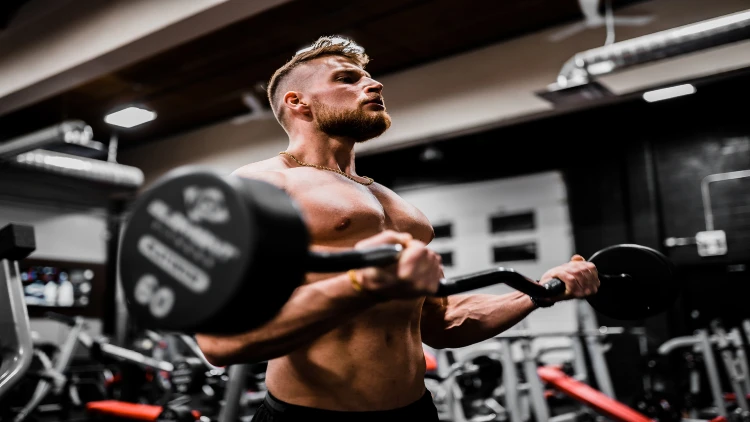
Photo by Anastase Maragos on Unsplash9
Barbell Shrugs
Barbell shrugs are a small movement that results in massive gains for the lifter targeting the rear delts and upper back. Due to the smaller range of motion, the lifter can go heavy on this exercise
How to perform barbell shrugs: To begin the exercise, the lifter should stand tall while holding the barbell with the hands slightly outside of the thighs. Lift the shoulders straight up, holding for between 1-2 seconds in this raised position, then lower back to the starting position. Ensure that throughout the movement that the shoulders are retracted, spine neutral and elbows straight.
- Reps: 12-15
- Sets: 3
- % of 1RM: 80
- RIR (Reps in Reserve): 1-3
- Rest: 60 seconds
- Superset with: Ring reverse fly
Landmine Press
Lifters doing landmine presses are seldom seen at the gym, but they are an excellent way of challenging the shoulders in a nonconventional way. It is also one of the vertical push exercises and great for those considering to develop their upper body strength and cannon shoulders.
The movement which involves pushing on an angled barbell is functional and carries over to daily activities.10 In addition to working the shoulders, this exercise activates the biceps, back and core muscles making them a complete shoulder and bicep workout.
How to perform the landmine press: These can be done either standing and/ or kneeling. While standing, hold the barbell with one hand and press the bar barbell straight up and lower back to the starting position. As the lifter lowers the bar, they should make sure to squeeze the arms to engage the biceps.
- Reps: 8-10
- Sets: 3
- % of 1RM: 70
- RIR (Reps in Reserve): 1-3
- Rest: 60 seconds
- Superset with: Kettlebell push press
Shoulder & Bicep Workout at Home (Body Weight & Calisthenics)
In addition to using barbells and dumbbells, lifters have their body weight at their disposal to provide resistance especially when training tools are not available.
Calisthenics is a form of strength training consisting of a myriad of compound movements that target multiple and large muscle groups and have been shown to help in weight loss, increase muscle, and these exercises have an advantage of weight lifting in terms of flexibility.11 However, weightlifting has been shown to be superior in allowing the lifter to gain muscle quicker.
The summary below gives a full arm and shoulder workout routine that a lifter can use to effectively grow their muscles with details following thereafter.
- Pike Push Ups: 5 sets of 8 reps with a RIR of 1-3
- Chin Up: 5 sets of 8 reps with a RIR of 1-3
- T Raise: 3 sets of 12 reps with a RIR of 1-3
Pike Push Ups
Pike pushups are a variation of the push up, and like the push up, are an old school exercise that target the shoulders and help build core strength. They are more challenging and lifters tend to do less of the same than they do push ups.
Pike push ups can help lifters at getting stronger in compound movements by providing a supplementary role. The primary muscles engaged are the rear deltoids, triceps, pecs, traps and the serratus anterior (fan shaped muscle that originates on the 1st to 8th or 9th ribs).
How to perform pike pushups: To initiate this exercise, the lifter should enter into a plank position with the arms shoulders width apart, ensuring that the shoulders are stacked (aligned) on the wrists. While engaging the core, walk towards the hands which will cause the hips to lift forming an inverted V-shape between the legs and torso.
Keep legs as straight as possible and lean forward and down by bending the elbows while tucking them. The head should gently touch the floor. Slowly push back up in a controlled manner engaging the core and lats. Repeat for desired reps.
- Reps: 8-12
- Sets: 5
- RIR (Reps in Reserve): 1-3
- Rest: 60 seconds
- Superset with: Pull ups
Chin Up
Chin ups are a variation of the traditional pull ups that place more focus on the biceps, but are also a back oriented exercise, targeting the lats in particular.
Exercises that involve vertical pulls are a must to include in workout programs to allow for a well-balanced physique and to counter the push exercises that may lead to rounding of shoulders—chin ups are also a more functional exercise that can carry over to daily activities.12
For added intensity, the lifter could do the eccentric (lowering phase) in a much slower manner which will lead to an increased time under tension for the biceps and lats.
How to perform chin ups: The lifter should grasp the bar using supinated grips (palms facing the body) about shoulder width. While taking a deep breath, engage the abs and squeeze the glutes and depress the shoulders while driving the elbows downwards towards the ground and activate the laps. Proceed by pulling the chin towards the bar until there is a feeling of full contraction in the lats and then with a slow movement, lower to the starting position.
- Reps: 6-15
- Sets: 5
- RIR (Reps in Reserve): 1-3
- Rest: 60 seconds
- Superset with: Dips
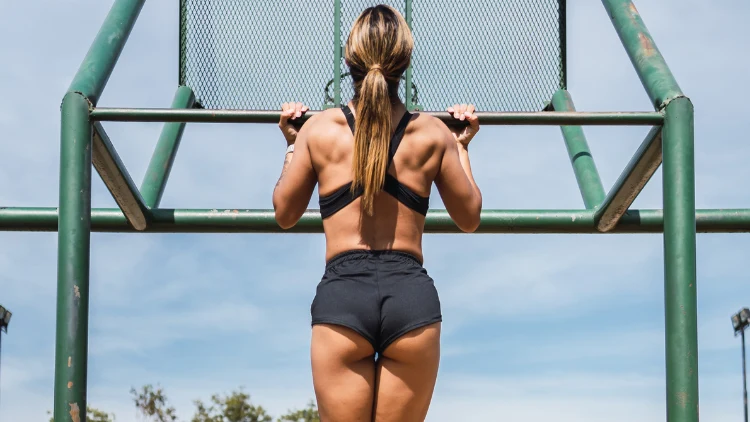
Source: renestevensphotos via Canva.com13
T Raise
T raises are a shoulder exercise that help the lifter address mobility and stability issues making them also ideal for those who spend majority of their time sited on a desk.
They help strengthen the shoulder muscles, requiring almost no equipment and are relatively safe to perform. T raises engage the rear deltoids, traps and rhomboids muscles of the back. Incorporating T-raises, this workout regimen enhances shoulder strength and mobility, benefiting individuals with sedentary lifestyles.
How to perform T raises: While lying on the floor with the chest down, either with dumbbells or not, place the arms in a hanging position with palms facing forward and thumbs pointing outwards. Activate the core, and ensure shoulder blades are retracted and proceed to raise the arms up to the side so that they are lined with the shoulders to perform a ‘T’ with the torso. Pause at this position briefly and slower the arms back down.
- Reps: 12-16
- Sets: 3
- RIR (Reps in Reserve): 1-3
- Rest: 30 seconds
Kettlebell Shoulder and Bicep Workout of the Day (WOD)
Lifters also have some cross fit type of movements at their disposal that they can include in their workout routine using kettlebells.
Crossfit is a type of training that involves high intensity movements, and they are functional oriented exercises that confer a wide variety of benefits such as enhancing lean mass, increasing strength, endurance and increasing the VO2max (the max amount of oxygen that can be consumed in an exercise).14
The use of kettlebells has many advantages including:
- Excellent for strength and cardio training.
- Abundance of kettlebell exercises.
- Highly efficient type of training as a lot of working out can be done with little time.
- Help enhance balance and coordination.
- Great for losing weight and toning up the muscles.
Crossfit can introduce variation to gym goers who are bored with everyday routines and overcome plateaus and the functional aspect enhances everyday activities such as squatting, jumping and lifting objects.
These ‘work out of the day’ exercises should help spice up a lifter’s regimen as well as help build superior strength and mass to the shoulders and biceps.
- Kettlebell Goblet Squats: Drop set of 50-40-30-20-10 exercises per round at 70% of 1RM (1 Rep Max) with a RIR of 1-3
- Kettlebell Swings: Drop set of 50-40-30-20-10 exercises per round at 70% of 1RM (1 Rep Max) with a RIR of 1-3
Should You Workout Shoulders and Biceps Together?
Training shoulders and biceps on the same day isn’t a common practice among many lifters, except for those participating in high-volume programs like 5-6 full-day routines. Whether to combine these muscle groups in a single workout session depends on individual fitness goals and program structure.
In these cases, it becomes a logical step to combine them into a workout on a single day. This approach allows the lifter to squeeze more out of a single workout to allow for time later in the week to train the shoulders and biceps for the second time as they would for example in say a 4 day workout split program.

Source: Leon Ardho via Canva.com15
Benefits of Working Out Shoulders & Biceps Same Day
Other than being able to train more frequently, lifters are able to exercise more efficiently and can overall improve their work capacity.
Increases training frequency— Training these muscle groups in one workout allows them to be hit again at least a second time in the same week. When lifters hit a muscle group at least twice a week instead of once a week, there is superior hypertrophy (muscle growth) compared to once a week—in addition, training them 3 times a week is more superior to training them twice a week.16
Efficient way to workout—With many lifters trying to fit gym time into their busy schedules, training this way becomes very efficient. It is not inherently a bad thing to train one muscle group for an hour, but this is inefficient and will likely require the lifter to spend 5-6 days at the gym. Combining the muscle groups means a lifter can train 3-5 times a week and still get a decent workout in.
Improvement in work capacity—By increasing and supersetting workouts by combining different muscle groups, the lifter’s capacity for endurance increases. They can increase volume and get more out of their workouts with shorter rest times. This also translates into increased hypertrophy and strength since the muscles are induced with more stress.
Tips to Get the Most Out of Your Shoulder & Bicep Workout
Lifters can improve and make the most of the workouts by including certain tips in their regimen. These include getting adequate training volume, ingesting enough calories and experimenting with different grip widths.
Getting adequate training volume and frequency—Lifters should strive to improve both training volume and frequency which primarily increases muscle hypertrophy (growth) and secondarily increases strength, while low volume and high intensity primarily increases strength while secondarily increasing muscle growth.17 Many lifters struggle with arm growth and often find that insufficient training volume is usually the main issue.
Paying attention to these volume landmarks below build muscle and gain strength using scientific principles that never change and are critical to achieving results:
- Minimum effective volume (MEV) which is the minimum amount of training to grow muscle.
- Maintenance volume (MV) which is the amount of volume needed to maintain muscle.
- Maximum adaptive volume (MAV) which is the range of volumes to make the best gains.
- Maintenance recoverable volume (MRV) which is the maximum amount of training to grow muscle before reaching overtraining.
Ingesting enough calories—Lifting weights develops muscle mass which leads to an increase in muscle-to fat-ratio; muscle requires a higher amount of calories to maintain. As a result, those looking to build their shoulders and biceps effectively should up their calorie intake by 350-450 kcal daily to effectively build muscle.18
Consuming sufficient protein—Muscle breaks down as a result of strength training and needs to be repaired and built (grown)—this process requires adequate amounts of protein. Protein contains amino acids such as leucine, dileucine, isoleucine, valine and branded amino acids (BCAA’s) required for this recovery.19 The recommended protein intake for those on a strength training regimen is 1.2-2 grams of protein daily per kilogram of bodyweight.20 Therefore, for example an individual weighing 130 pounds (58kg*) should consume 116 grams of protein on a daily basis.
Keeping a mind muscle connection—Mind muscle connection refers to paying attention to the muscle as it is contracted during exercising. Doing this will increase its activation and will also keep out other muscles that shouldn’t be part of the movement from helping the primary movers.
Experimenting with different grip widths—Varying grip widths will ensure different muscle groups are trained differently. For example, a wide grip in a bicep curl will activate the inner (short) head while a narrower grip will place more focus on the outer (long) head of the biceps muscle; therefore lifters should strive to use varying widths to get an effective workout.
Trying different angles—Angles have a profound effect on the activation of muscles because each joint in the body has an angle that is optimal to its function since it will be at an optimum length to exert the highest amount of force and contraction. The biceps have the highest activation and strength when the joint is placed at an angle of 56 degrees; therefore lifters should always change the angle to induce the maximal activation.21
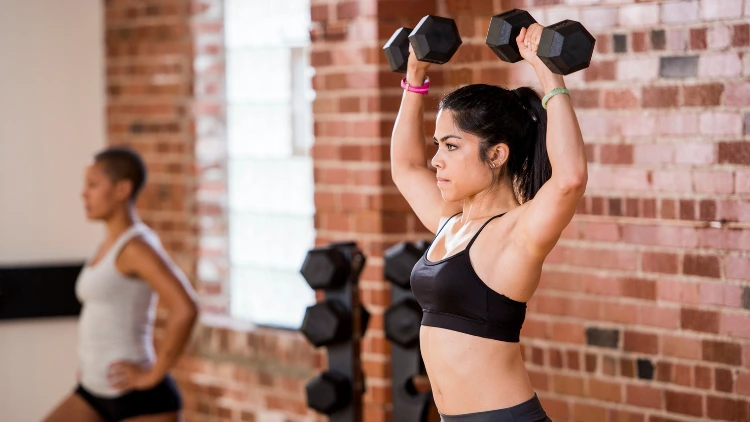
Source: FatCamera via Canva.com22
Elbow placement—Maintaining an ideal elbow position is important to ensure increased activation of the biceps. The biceps flexes the elbow and also gives a forward flexion to the shoulders (similar to an uppercut movement)—curling does not take into consideration the flexion of shoulders.
Lifters should keep the elbows pinned to the torso as they begin curling until they are at the end of range of motion, they should then bring the elbows forward a couple of inches squeezing the biceps. Elbows should not be brought forward during the start and there should be no swinging of the elbows during the movement.
Recovery and sleep—it is imperative to allow the body to recover from training days, giving them at least 48 hours to prevent overtraining, exhaustion and injury. Inadequate rest after workouts can also cause bicep curl wrist twitch. Getting sufficient sleep is also crucial to ensure muscle strength remains at peak levels to safeguard efficient workouts.23
The shoulders and biceps can give the lifter big arms and add to the sought after v-taper shape that defines the stereotype bodybuilder. Performing this shoulder and bicep workout routine should set someone on the path to achieving this by using this proven trick for more mass by ensuring that all heads of the muscle are activated and paying mind to volume landmarks to gradually increase mass and strength.
Frequently Asked Questions
When Should I Do Supersets?
The use of supersets should be determined by what the training objectives of the lifter are: they could be used to cut down the time it takes to complete a workout and increase the overall work capacity a lifter could incorporate—that is to increase the amount of training they can put in into a workout.
Alternatively, some lifters may be looking to increase training volume and time under tension to achieve muscle growth as in the case of the bodybuilders. Lastly, supersets can aid those looking to enhance their performance by using complementary pairs to double their training to enhance strength and power.
How Do You Hit All 3 Shoulder Muscles?
While the staple overhead shoulder press can target all 3 heads of the shoulder muscles, the rear and the front tend to get more focus. To hit all 3 heads, employing the Arnold press, will engage all 3 heads due to its rotational movement. The lateral raise can be added to activate the side delts and the reverse incline bench barbell upright row can be used to focus on the rear delts.
How Do You Hit Both Bicep Heads?
Both bicep heads are involved and active in all biceps exercises and this is proven in studies; however, it is possible to elicit activation in one head over the other with different exercises. To work the long head of the bicep, it is viable to be in an incline position (like when doing incline dumbbell curls) which places the shoulder in a hyper extended stance that leads to stretching of the long head that runs over the shoulder joint.
As a result, this head is now in a primed position to produce more contraction. Engaging the short head will require a combination of flexing the arm and having the palms in a supinated (palms facing up) position—concentration curls fit the bill for this arrangement.
Finally, the brachialis which are among the reverse curl muscles worked, is normally a neglected muscle that is located beneath the biceps and also plays a role in elbow flexion. When this is well developed, it pushes up the biceps providing a better peak look. This muscle has only one role, and that is to flex the arms and has no role in turning the wrist; therefore exercises that flex the arm with a pronated (palms facing down) grip will focus more on the brachialis then the biceps. Exercises like reverse EZ bar curls will activate this muscle.
What Are the Effective Workouts for Shoulders and Biceps?
A workout focused on the shoulders and biceps is ideal for individuals who want to divide their exercise sessions to effectively target these muscles multiple times. Examples of these include 5 day power building split, 4 day split, bro split, 6 day workout routine plan, push pull legs and upper and lower body splits—these will all benefit from combining these two workouts.
References
1Poplavsky, Andrew. Canva. Accessed 21 April 2023. <https://www.canva.com/photos/MACXss-qwwA-tattooed-male-doing-a-biceps-workout/>
2Lidong Gao, Z. L. (2022, June 22). Influence of Different Load Conditions on Lower Extremity Biomechanics during the Lunge Squat in Novice Men. Retrieved 2023, from <https://pubmed.ncbi.nlm.nih.gov/35877323/>
3milan2099. Canva. Accessed 21 April 2023. <https://www.canva.com/photos/MAEEPvSzCk0-biceps-workout/>
4Yuri A. C. Campos, J. M.-M. (2020, October 31). Different Shoulder Exercises Affect the Activation of Deltoid Portions in Resistance-Trained Individuals. Retrieved 2023, from <https://www.ncbi.nlm.nih.gov/pmc/articles/PMC7706677/>
5Nazarov, Sergey. Canva. Accessed 21 April 2023. <https://www.canva.com/photos/MAEhHeRtomo-girl-performing-dumbbell-lateral-raise-on-maroon-background/>
6Giuseppe Marcolin, F. A. (2018, July 13). Differences in electromyographic activity of biceps brachii and brachioradialis while performing three variants of curl. Retrieved 2023, from <https://www.ncbi.nlm.nih.gov/pmc/articles/PMC6047503/>
7Ibrakovic. Canva. Accessed 21 April 2023. <https://www.canva.com/photos/MADBbPH-A5E-mature-man-doing-dumbbell-incline-bench-press-workout/>
8Jordan Kroell, J. M. (2017, December). Exploring the Standing Barbell Overhead Press. Retrieved 2023, from <https://aquila.usm.edu/fac_pubs/17605/>
9Maragos, Anastase. “topless man in black shorts carrying black dumbbell photo – Free Fitness Image on Unsplash.” Unsplash, 6 February 2020. Accessed 21 April 2023. <https://unsplash.com/photos/7kEpUPB8vNk>
10Academy, A. F. (2019, March 27). FULL BODY LANDMINE WORKOUT. Retrieved 2023, from <https://www.fitnesseducation.edu.au/blog/personal-training/full-body-landmine-workout/>
11University, P. S. (2015). Weight Lifting or Calisthenics. Retrieved 2023, from <https://sites.psu.edu/siowfa15/2015/12/03/weight-lifting-or-calisthenics/>
12Kenji Doma, G. B. (2013, September 12). Kinematic and electromyographic comparisons between chin-ups and lat-pull down exercises. Retrieved 2023, from <https://pubmed.ncbi.nlm.nih.gov/24245055/>
13renestevensphotos. Canva. Accessed 21 April 2023. <https://www.canva.com/photos/MAEk1C9Wpcc-athlete-doing-pull-ups/>
14Sebastian Wagener, M. W. (2020, September 4). CrossFit® – Development, Benefits and Risks. Retrieved 2023, from <https://www.ncbi.nlm.nih.gov/pmc/articles/PMC7473349>
15Ardho, Leon. Canva. Accessed 21 April 2023. <https://www.canva.com/photos/MADlI_GCjS8-woman-lifting-barbell/>
16Brad J Schoenfeld, D. O. (2016, November). Effects of Resistance Training Frequency on Measures of Muscle Hypertrophy: A Systematic Review and Meta-Analysis. Retrieved 2023, from <https://pubmed.ncbi.nlm.nih.gov/27102172/>
17Gerald T Mangine, J. R. (2015, August 13). The effect of training volume and intensity on improvements in muscular strength and size in resistance-trained men. Retrieved 2023, from <https://www.ncbi.nlm.nih.gov/pmc/articles/PMC4562558/>
18Gary John Slater, B. P. (2019, August 20). Is an Energy Surplus Required to Maximize Skeletal Muscle Hypertrophy Associated With Resistance Training. Retrieved 2023, from <https://www.ncbi.nlm.nih.gov/pmc/articles/PMC6710320/>
19YATES, D. (2021, August 9). Study identifies molecule that stimulates muscle-building. Retrieved 2023, from <https://news.illinois.edu/view/6367/738187139>
20Tyler Becker. (2017, February 14). Protein intake for athletes. Retrieved 2023, from <https://www.canr.msu.edu/news/protein_intake_for_athletes>
21Jeongok Yang, J. L. (2014, July 30). The Effects of Elbow Joint Angle Changes on Elbow Flexor and Extensor Muscle Strength and Activation. Retrieved 2023, from <https://www.ncbi.nlm.nih.gov/pmc/articles/PMC4135202/>
22FatCamera. Canva. Accessed 21 April 2023. <https://www.canva.com/photos/MAED4YgsDM4-dumbbell/>
23Olivia E Knowles, E. J. (2018, September). Inadequate sleep and muscle strength: Implications for resistance training. Retrieved 2023, from <https://pubmed.ncbi.nlm.nih.gov/29422383/>